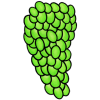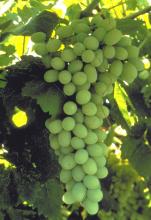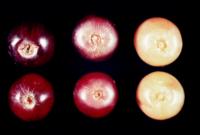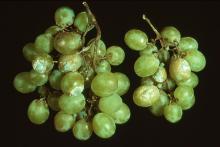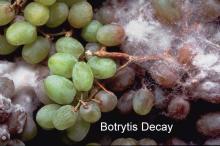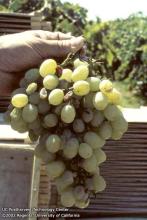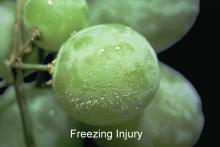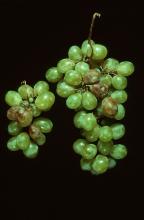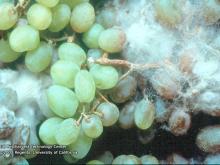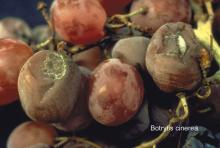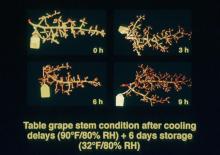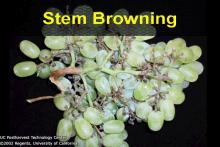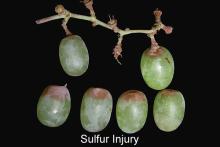Maturity and Quality
In California, harvest date is determined by Soluble Solids Concentration (SSC) of 14 to 17.5% depending on cultivar and production area. In some situations, the SSC/titratable acidity (TA) ratio of 20 or higher is used to determine maturity for early maturing cultivars from early production areas. For red and black colored cultivars, there is also a minimum color requirement.
- High consumer acceptance is attained for fruit with high SSC or SSC/TA ratio
- Berry firmness is also an important factor for consumer acceptance as are lack of defects such as decay, cracked berries, stem browning, shriveling, sunburned or dried berries, and insect damage
Postharvest Handling and Storage
Berry storage at -1.0 to 0°C (30-32°F) is recommended.
The highest freezing point for berries is -2.7°C (27.1°F), but freezing point varies (down to -3.0°C (26.6°F) depending on SSC. A -2.0°C (28°F) stem freezing point has been reported.
(of grape clusters, i.e. berries + stems)
| Temperature | 0°C (32°F) | 5°C (41°F) | 10°C (50°F) | 20°C (68°F) |
|---|---|---|---|---|
| ml CO2/kg·hr | 1-2 | 3-4 | 5-8 | 12-15 |
Stem respiration rate is approximately 15 times higher than berry respiration.
To calculate heat production, multiply ml CO2/kg·hr by 440 to get BTU/ton/day or by 122 to get kcal/metric ton/day.
Table grapes are not very sensitive to ethylene. However, exposure to ethylene (>10 ppm) may be a secondary factor in shatter.
90-95% RH and an air velocity of approximately 20-40 feet per minute (FPM) is suggested during storage.
CA (2-5% O2 + 1-5% CO2) during storage/shipment is not currently recommended for table grapes because its benefit is slight and SO2 used for decay control.
Effects of Genotype on Market Life
Market life varies among table grape cultivars grown in California and is also strongly affected by temperature management and decay susceptibility.
Temperature & Controlled Atmosphere Photos
Title: SO2 Injury
Photo Credit: Carlos Crisosto, UC Davis
Disorders
Shatter. (Loss of berries from the cap stem) In general, shatter increases in severity with increasing maturity, i.e., the longer the fruit remains on the vine. Berries of seedless cultivars, are usually less well attached to the cap stem than seeded cultivars. Shatter varies considerably from season to season, and there is a large difference among varieties. Gibberellin applied at fruit set weakens berry attachment. Shatter occurs mainly due to rough handling during field packing with additional shatter occurring all the way to the final retail sale. Shatter incidence can be reduced by controlling pack depth and fruit packing density (cubic inches per pound), using cluster bagging, gentle handling and maintaining recommended temperature and relative humidity.
Waterberry. Waterberry is associated with fruit ripening and most often begins to develop shortly after veraison (berry softening). The earliest symptom is the development of small (1-2 mm) dark spots on the cap stems (pedicles) and/or other parts of the cluster framework. These spots become necrotic, slightly sunken, and expand to affect more areas. The affected berries become watery, soft, and flabby when ripe. In California, this disorder has been associated with a high nitrogen status vine, canopy shading, or cool weather during veraison and fruit ripening. Avoid over fertilization with nitrogen. Foliar nutrient sprays of nitrogen should be avoided in waterberry-prone vineyards. Trimming off affected berries during harvest and packing is a common practice, although labor intensive.
Gray Mold (Botrytis cinerea). Gray mold is the most destructive of the postharvest diseases of table grapes, primarily because it develops at temperatures as low as 31°F (-0.5°C) and grows from berry to berry. Gray mold first turns berries brown, then loosens the skin of the berry, its white, thread-like hyphal filaments erupt through the berry surface, and finally masses of gray colored spores develop. Wounds near harvest also provide opportunities for infections. No wound is required for infection when wet conditions occur.
Botrytis infection can be reduced by removing desiccated, infected grapes of the previous season from vines, leaf-removal canopy management, preharvest fungicides, trimming visibly infected, split, cracked, or otherwise damaged grapes before packing, prompt cooling and fumigation with sulfur dioxide (100 ppm for one hour) or use of continuous release SO2 pads.
For more information, see our publications “Harvesting and Handling California Table Grapes for Market” and “Packing California Table Grapes” available for purchase using our Publication order form.



